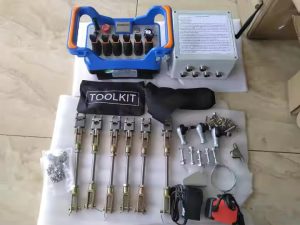
FREE QUOTE
1. What is a wireless industrial remote control?
A wireless industrial remote control is an advanced device designed to operate machinery and equipment without the need for physical connections. By leveraging radio frequency (RF) or other wireless technologies, it allows operators to manage industrial processes from a distance, enhancing flexibility and safety.
2. How does a wireless industrial remote control benefit my operations?
Wireless remote controls offer several key benefits:
- Increased Flexibility: Operators can control machinery from a safe distance, allowing for better maneuverability and reducing the need for physical presence in hazardous areas.
- Enhanced Safety: By eliminating physical connections, the risk of accidents caused by tripping over wires or being exposed to dangerous equipment is minimized.
- Improved Efficiency: Wireless controls streamline operations by providing quick and easy access to machinery functions, leading to faster setup and operation times.
3. What industries can benefit from using wireless industrial remote controls?
Wireless industrial remote controls are versatile and can be beneficial across various industries, including:
- Manufacturing: Streamline production lines and enhance operator safety.
- Construction: Improve the efficiency of heavy equipment and machinery on site.
- Mining: Enable remote operation of mining equipment, reducing operator exposure to hazardous conditions.
- Agriculture: Facilitate the operation of farm machinery from a distance, increasing productivity and safety.
4. What features should I look for in a wireless industrial remote control?
When choosing a wireless industrial remote control, consider the following features:
- Range and Signal Strength: Ensure the remote has adequate range and reliable signal strength for your operational needs.
- Durability: Look for a rugged design that can withstand harsh industrial environments.
- Ease of Use: An intuitive interface and ergonomic design will enhance usability and reduce the learning curve for operators.
- Customization: Check if the remote control can be customized to suit specific machinery and operational requirements.
5. Are there any limitations or challenges associated with wireless industrial remote controls?
While wireless industrial remote controls offer numerous advantages, there are some considerations to keep in mind:
- Signal Interference: In environments with heavy machinery or electronic devices, signal interference can occasionally affect performance. Opt for devices with strong signal processing capabilities to mitigate this.
- Power Management: Wireless devices rely on batteries or other power sources. Regular maintenance and monitoring of power levels are essential to avoid unexpected downtime.
6. How can I integrate a wireless industrial remote control into my existing systems?
Integration typically involves the following steps:
- Compatibility Check: Ensure the remote control is compatible with your existing machinery and systems.
- Installation: Follow the manufacturer’s instructions for installation, which may include setting up receivers or adapters on your equipment.
- Training: Provide training for your operators to ensure they are familiar with the new system and can use it effectively.
7. What does the future hold for wireless industrial remote controls?
The future of wireless industrial remote controls is promising, with advancements in technology likely to bring:
- Enhanced Connectivity: Improved wireless technologies will offer greater range and reliability.
- Smart Features: Integration with IoT and smart technologies will enable more advanced control and monitoring capabilities.
- Increased Customization: More options for customization will allow better adaptation to specific industrial needs.
Conclusion
Wireless industrial remote controls are transforming the way industries operate, offering increased flexibility, safety, and efficiency. By understanding their benefits, features, and potential challenges, you can make an informed decision about incorporating this technology into your operations. Explore the possibilities and future-proof your industrial processes with cutting-edge wireless solutions.


